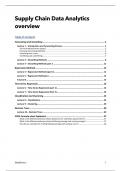Class notes
Supply Chain Data Analytics (SCDA) Summary plus formula sheet notes
- Course
- Institution
- Book
This document contains a profound overview of most course material relevant to the (resit) exam of Supply Chain Data Analytics (E_TSCM_SCDA), a course provided by Vrije Universiteit Amsterdam for the study MSc Transport & Supply Chain Management. The file covers lecture material, tutorial notes (r...
[Show more]




